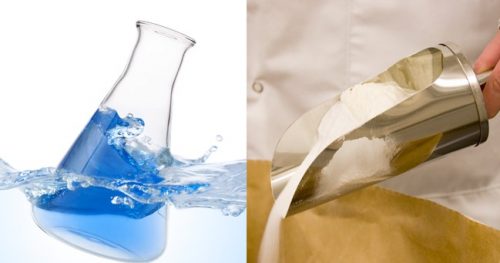Unlock the Superior Power of Liquid Concentrates
Tweet
 Print
Print
Should I choose a liquid concentrate or a powdered detergent for critical cleaning applications?
With so many choices out there it can be difficult to figure out which cleaner is the best choice for your critical cleaning applications. After considering factors such as the surface being cleaned, the soil, the wash method and the proper temperature, the next thing to think about is whether to choose a powdered detergent or a liquid concentrate.
Some advantages of using a liquid concentrate rather than a powdered detergent are:
- powders can be messy and can create dust or powder clouds
- concentrates are quicker and easier to mix
- concentrates do not require agitation to mix
- concentrates mix instantly in either cold or hot water
- concentrates create a more homogeneous solution, powders can settle at the bottom
How do I determine the proper concentration of detergent?
Using the proper concentration of detergent is a key factor in determining your optimum cleaning process. This is not a case of the classic ‘more is better’ adage; using too much detergent can be as disruptive to your outcome as using too little. The recommended concentration of detergent in your solution may vary depending on the detergent itself, the soil, the substrate, the temperature and the cleaning method.
When comparing different cleaning products, a cleaner that appears to be more costly on the surface may indeed be the more economical choice in the long run if a lower concentration of detergent is needed for each cleaning cycle. Follow the manufacturer’s guidelines for determining the correct strength of your cleaning solution. International Products Corporation recommends a 1% – 2% concentration of their cleaners for most applications.
How do I prepare the cleaning solution and how much cleaner should I add to my tank?
IPC recommends pouring the water into the tank first and then adding the detergent. This helps to avoid excess foaming when preparing your cleaning solution. The chart below is helpful in determining the amount of cleaner to be added to a tank:
| U.S. Tank Sizes
(concentration of cleaner) |
||||
| Tank Size | 0.5% | 1.0% | 2.0% | 5.0% |
| 1 Quart | 1/6 ounce | 1/3 ounce | 2/3 ounce | 1½ ounces |
| 1 Gallon | 2/3 ounce | 1¼ ounces | 2¾ ounces | 6½ ounces |
| 3 Gallons | 2 ounces | 3¾ ounces | 7¼ ounces | 19¼ ounces |
| 5 Gallons | 3¼ ounces | 6½ ounces | 12¾ ounces | 1 quart |
| 10 Gallons | 6½ ounces | 12¾ ounces | 25½ ounces | 2 quarts |
| 25 Gallons | 16 ounces | 1 quart | 2 quarts | 1¼ gallons |
| 50 Gallons | 1 quart | 2 quarts | 1 gallon | 2½ gallons |
| 100 Gallons | 2 quarts | 1 gallon | 2 gallons | 5 gallons |
| Metric Tank Sizes
(concentration of cleaner) |
||||
| Tank Size | 0.5% | 1.0% | 2.0% | 5.0% |
| 1 Liter | 5 ml | 10 ml | 20 ml | 50 ml |
| 4 Liters | 20 ml | 40 ml | 80 ml | 200 ml |
| 10 Liters | 50 ml | 100 ml | 200 ml | 500 ml |
| 20 Liters | 100 ml | 200 ml | 400 ml | 1 liter |
| 40 Liters | 200 ml | 400 ml | 800 ml | 2 liters |
| 100 Liters | 500 ml | 1 liter | 2 liters | 5 liters |
| 200 Liters | 1 liter | 2 liters | 4 liters | 10 liters |
| 400 Liters | 2 liters | 4 liters | 8 liters | 20 liters |
For assistance in determining your optimum cleaning regimen, including choosing the right cleaner and determining the proper concentration of detergent, contact International Products Corporation.
Tweet
 Print
Print